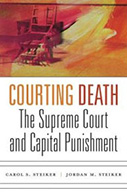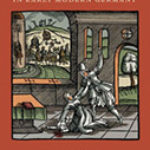Courting Death: The Supreme Court And Capital Punishment

Authors: Carol S. Steiker and Jordan M. Steiker
Publisher: Cambridge, MA: The Belknap Press of Harvard University Press, 2016. 390 pp.
Reviewer: Michael L. Radelet | March 2017
Over the forty years since I began to study the death penalty, I have often replied to questions that stumped me by explaining that I am but a simple sociologist, and therefore cannot claim license to understand the rationality behind scores of (seemingly) strange Supreme Court decisions on the death penalty since the Furman case in 1972. Now come Carol and Jordan Steiker, the sister-brother team from Harvard and Texas Law Schools respectively, who have effectively eliminated my excuse. It turns out that justices, judges, law school professors, practicing attorneys, and regular old sociologists are bound by a common inability to find much rationality in the rules that govern these life-or-death decisions.
Courting Death, as the title suggests, is not only about how American courts have tried (and failed) to regulate our “system” of capital punishment, but also how appellate courts are generally in love with the practice, and often appear to try very hard to look the other way and stamp almost any death penalty case as “good enough for government work.” In so doing, the courts have created the false impression that the death penalty today is really reserved for the worst of the worst, even though (at least arguably) the best predictor of who ends up on our gurneys is often the defendant with the worst attorneys, those with white and/or female victims, or perhaps the defendants who just had plain old bad luck. While all stand convicted of murder, it is virtually impossible to distinguish within this group (at least with legally-relevant variables) who will live and who will die.
The book begins by noting that over 8,000 people have been sentenced to death in American jurisdictions since the “modern” era of the death penalty began in 1972, when states tried to figure out how to tinker with the death penalty statutes that had effectively been tossed out in June of that year by the Supreme Court. In November 1972, Florida passed the first “post-Furman” statute, and that statute was approved by the Supreme Court in 1976. A year later, Gary Gilmore in Utah became the first inmate in the modern era to be sent to the hereafter (and by a firing squad, no less), and by the end of 2016, some 1,426 men and 16 women had likewise been dispatched. But, as the authors point out, over 80 percent of those sentenced to death since 1972 have not been executed, including some 2,900 that sit on American death rows today. The twenty people put to death in 2016 were on death row for an average of just under 19 years (those who drop their appeals tend to stay there for shorter periods), leading federal Judge Cormac Carney to label today’s death penalty as effectively “life imprisonment with a remote possibility of death” (p. 1, 275). Notably, while some of those executed inmates were on death row for only a dozen years or so, a couple of others were there for over 30 years. Those are the “lucky” ones who had trial attorneys who knew how to preserve the record and make timely objections.
Until the 1960s, the Supreme Court basically stayed away from death penalty cases. Nonetheless, the Steikers point out that America has seen a gradual movement away from the death penalty that began as early as the mid-nineteenth century. The number of crimes eligible for the death penalty fell, and a few states, led by Michigan, started to abolish the death penalty as early as 1850 or so. States also got rid of mandatory death penalty statutes and authorized juries to impose prison sentences in lieu of the death penalty if they so wished. Public executions were gradually banned, although it took a century (from the 1830s and the 1930s) to totally abolish the practice. Perhaps most importantly, the book shows that over the last 125 years we have searched for more “humane” ways to put people to death, allowing readers to see the similarities between today’s debates about botched lethal injections and our great-grandparents’ concerns with botched hangings. The long view provided by the Steikers clearly shows that today’s abolitionists are on firm ground when they argue that history is on their side.
In the 1960s, led by the NAACP Legal Defense Fund and one of the foremost litigators of the twentieth century, law professor Anthony Amsterdam, five broad challenges to the death penalty made their way to the Supreme Court: mandatory exclusion from capital juries of citizens who stood against the death penalty, “discretion without standards, racial discrimination, lack of proportionality, and unitary proceedings” (p. 45). In the 1972 Furman case, the death penalty itself was quashed by the Supreme Court, and many observers thought that the U.S. would never host an execution again. How wrong they were. In the aftermath, states began to construct statutes that gave jurors guidelines to use in making the life-or-death decisions, and the guilt phase of capital trials was separated from the sentencing phase. But the Court never addressed (or decided to disregard) the elephant in the room: massive racial bias, today manifested mainly by race-of-victim disparities. Here, the authors call the 1987 decision in McCleskey v. Kemp a “missed opportunity for heightened reliability” (p. 174). As the Steikers put it (p. 79), the race issue has been “hiding in plain sight,” and has been met by the courts with “deafening silence” (p. 98). “By failing to look at the death penalty through the lens of race, the Court has limited the capacity of death penalty law to see and respond to racial injustice” (p. 111).
As a result of all this post-Furman litigation, “[r]egulation, which the Court embraced to make the administration of the death penalty more consistent and uniform, has produced state capital systems that are worlds apart” (p. 121). In effect, “[w]e have replaced a lottery for death sentences with a lottery for executions” (p. 118). At the same time, however, these efforts to regulate “have been insufficient to redress the arbitrary and discriminatory imposition of death that prompted the Court to intervene in the first place” (p. 155). In fact, the principal effects of the Court’s efforts to regulate the death penalty seem to be to further legitimate it by creating the false illusion that in today’s world, our death penalty practices are effective at preventing abuses, ensuring fairness, and making sure that only the guilty are condemned to death.
In this century, the massive cost of capital cases, the concern about wrongful convictions, and the widespread availability of life-without-parole sentences, among other factors, have resulted in a dramatic decline in new death sentences, executions, and even the number of states that retain the death penalty in their law books. Since the Furman decision, Justices Marshall, Brennan, Blackmun, Powell, Stevens, and now Breyer and Ginsburg (in a 2015 case, Glossip v. Gross) have all expressed reservations about the constitutionality of the death penalty, and the authors believe it is very possible that other justices in the future will do likewise. Indeed, the authors offer what they call a “blueprint for constitutional abolition” (p. 271) that gives a roadmap for how the Court, in a “Furman II” decision, could decide to scrap every execution chamber in America. Of course, when the book went to press in mid-2016, few observers foresaw the election of President Donald Trump, and – to say the least – it is unlikely that he will nominate any opponent of the death penalty to future open seats on the Court.
Nonetheless, it is very possible that Americans will eventually decide that the death penalty is a sentence that is simply not worth the hassles and a punishment that we can do without. The book concludes with a chapter that discusses how the death penalty distorts the entire criminal justice system, by (for example) making other severe punishments appear normal and legitimating the massive increases in prison populations that we have seen over the past three decades. Their analysis could even be taken one step further: how could the personnel and treasure that is today used in death penalty litigation be redirected in ways that offer more promise in reducing rates of criminal violence or rendering genuine aid to families of homicide victims?
What I like best about this book is the way that it connects the dots. The 45 years since the Furman decision have seen all sorts of odd decisions and non-decisions, with the resulting death sentencing system resembling a building that was constructed by dozens of different companies, none of whom employed the same architect. But now that 45 years have passed and we have a wide-ranging “big picture” book like the Steikers have given us, we can begin to see the forest and not simply the individual trees.
Over the years I have been involved in occasional discussions with other death penalty researchers about our picks for the top handful of books or articles published in recent years that have addressed the death penalty. Two ethnographies, Dead Man Walking and Just Mercy, are at the top of almost all lists, as are Banner’s The Death Penalty and Bedau’s The Death Penalty in America. Now, Courting Death will be a welcome addition to that list. This is a very important and useful book.
Michael L. Radelet, Professor of Sociology, University of Colorado-Boulder, USA.


